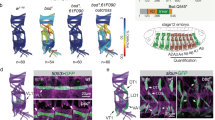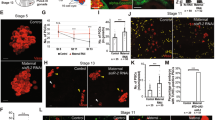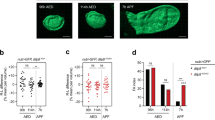Abstract
THE early developmental period in Drosophila is characterized by rapid mitotic divisions, when the body pattern becomes organized by a cascade of segmentation gene activity1,2. During this process localized expression of the gap gene knirps (kni) is required to establish abdomen segmentation3,4. The knirps-related gene (knrl) encodes a kni-homologous nuclear hormone receptor-like protein5,6 and shares the spatial patterns of kni expression. The two genes differ with respect to the size of their transcription units; kni contains 1 kilobase and knrl 19 kilobases of intron sequences. The consequence of this difference in intron size is that knrl cannot substitute for kni segmentation function, although it gains this ability when expressed from an intronless transgene. Here we show that the length of mitotic cycles provides a physiological barrier to transcript size, and is therefore a significant factor in controlling developmental gene activity during short 'phenocritical' periods. The required coordination of cycle length and gene size provides severe constraints towards the evolution of rapid development.
This is a preview of subscription content, access via your institution
Access options
Subscribe to this journal
Receive 51 print issues and online access
$199.00 per year
only $3.90 per issue
Buy this article
- Purchase on Springer Link
- Instant access to full article PDF
Prices may be subject to local taxes which are calculated during checkout
Similar content being viewed by others
References
Akam, M. Development 101, 1–22 (1987).
Ingham, P. Nature 335, 25–34 (1988).
Lehmann, R. Development 104 (suppl.), 17–27 (1988).
Nauber, U. et al. Nature 336, 489–492 (1988).
Oro, A. E. et al. Nature 336, 493–496 (1988).
Rothe, M., Nauber, U. & Jäckle, H. EMBO J. 8, 3087–3094 (1989).
Evans, R. M. Science 240, 889–895 (1988).
Green, S. & Chambon, P. Trends Genet. 4, 309–314 (1989).
Oro, A. E., Umesono, K. & Evans, R. M. Development 107 (suppl.), 133–140 (1989).
Hoch, M., Gerwin, N., Taubert, H. & Jäckle, H. Science 256, 94–97 (1992).
Campos-Ortega, J. A. & Hartenstein, V. The Embryonic Development of Drosophila melanogaster (Springer, Berlin, 1985).
Foe, V. E. & Alberts, B. J. Cell Sci. 61, 31–70 (1983).
Foe, V. E. Development 107, 1–22 (1989).
Shermoen, A. W. & O'Farrell, P. H. Cell 67, 303–310 (1991).
Pankratz, M. J. et al. Cell 61, 309–317 (1990).
Tautz, D. & Pfeifle, C. Chromosoma 98, 81–85 (1989).
Edgar, B. & O'Farrell, P. H. Cell 52, 469–480 (1990).
Macdonald, P. M. & Struhl, G. Nature 324, 537–545 (1986).
Lehmann, R. thesis, Univ. Tübingen (1985).
Strecker, T. R., Kongusuwan, K., Lengyel, J. A. & Merriam, J. R. Devl Biol. 113, 64–74 (1986).
Pankratz, M. J., Busch, M., Hoch, M., Seifert, E. & Jäckle, H. Science 255, 986–989 (1992).
Rubin, G. M. & Spradling, A. C. Nucleic Acids Res. 11, 6341–6351 (1983).
Pirrota, V. Vectors, A Survey of Molecular Cloning Vectors and their Use (eds Rodriguez, R. L. & Denhardt, D. T.) 437–456 (Butterworth, Boston, 1988).
Theurkauf, W. E., Baum, H., Bo, J. & Wensink, P. C. Proc. natn. Acad. Sci. U.S.A. 83, 8477–8481 (1986).
Karch, F., Török, I. & Tissieres, A. J. molec. Biol. 148, 219–230 (1981).
Spradling, A. C. Drosophila, A Practical Approach (ed. Roberts, D. B.) 175–197 (IRL, Oxford, 1986).
Struhl, G. Nature 338, 741–744 (1989).
Driever, W. & Nüsslein-Volhard, C. Nature 337, 138–143 (1989).
Sambrook, J., Fritsch, E. F. & Maniatis, T. Molecular Cloning (Cold Spring Harbor Laboratory, New York, 1989).
Studier, F. W. & Moffat, B. A. J. molec. Biol. 189, 113–130 (1986).
Hoch, M., Seifert, E. & Jäckle, H. EMBO J. 10, 2267–2278 (1991).
Krasnow, M. A., Saffman, E. E., Kornfeld, K. & Hogness, D. S. Cell 57, 1031–1043 (1989).
Gorman, C. M., Moffat, L. F. & Howard, B. H. Molec. cell. Biol. 2, 1044–1051 (1982).
Merrill, P., Sweeton, D. & Wieschaus, E. Development 104, 495–509 (1988).
Author information
Authors and Affiliations
Rights and permissions
About this article
Cite this article
Rothe, M., Pehl, M., Taubert, H. et al. Loss of gene function through rapid mitotic cycles in the Drosophila embryo. Nature 359, 156–159 (1992). https://doi.org/10.1038/359156a0
Received:
Accepted:
Issue Date:
DOI: https://doi.org/10.1038/359156a0
This article is cited by
-
Incorporation of CENP-A/CID into centromeres during early Drosophila embryogenesis does not require RNA polymerase II–mediated transcription
Chromosoma (2022)
-
Mechanisms regulating zygotic genome activation
Nature Reviews Genetics (2019)
-
Pure early zygotic genes in the Asian malaria mosquito Anopheles stephensi
Parasites & Vectors (2018)
-
The gap gene network
Cellular and Molecular Life Sciences (2011)
-
Hox genes and the diversification of insect and crustacean body plans
Nature (1995)
Comments
By submitting a comment you agree to abide by our Terms and Community Guidelines. If you find something abusive or that does not comply with our terms or guidelines please flag it as inappropriate.



